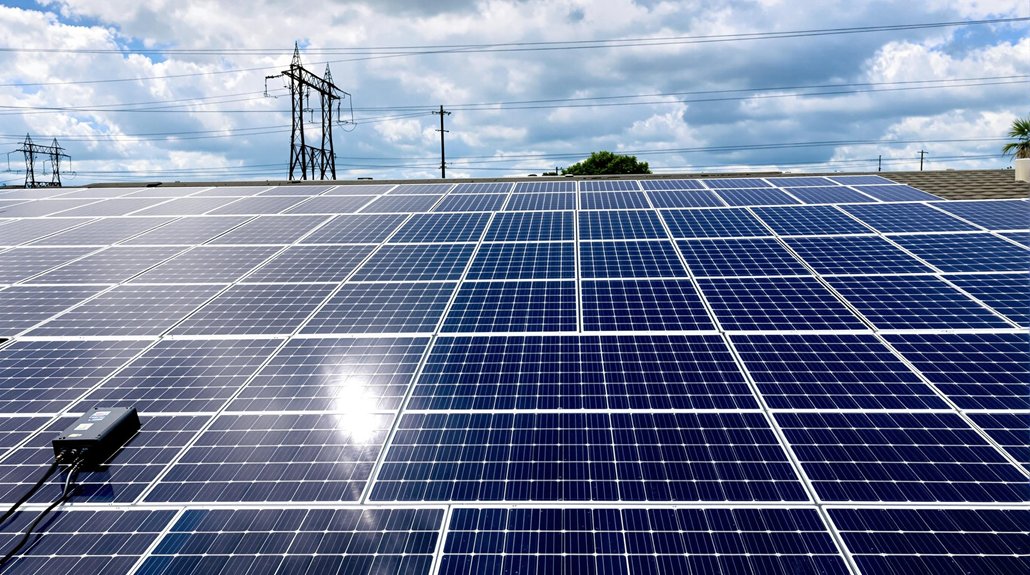Solar energy is booming across the United States. The nation reached 219 gigawatts of capacity in 2023, powering 37 million homes. Installations grew by 76% compared to 2022, with solar accounting for 64% of new grid additions in 2024. The industry now employs nearly 280,000 Americans, with jobs increasing in 47 states. Panel costs have dropped 40% over a decade. These impressive numbers tell only part of the story.

As the world seeks cleaner energy sources, solar power has emerged as a dominant force in the U.S. energy landscape. The nation’s solar capacity reached 219 gigawatts in 2023, providing enough electricity to power 37 million American homes. This growth shows no signs of slowing down, with solar accounting for 64% of all new generating capacity added to the U.S. grid in 2024.
The numbers tell a compelling story of expansion. U.S. solar installations grew by 76% in 2023 compared to the previous year. By 2024, Americans had installed over 5.3 million solar systems nationwide. The residential sector set a record with 6.9 gigawatts of new installations in 2023, while utility-scale solar capacity grew to 107.4 gigawatts by August 2024. U.S. solar power production has increased over eight times since 2014, demonstrating remarkable growth in just a decade.
U.S. solar growth surges with 76% increase in 2023 and 5.3 million systems now powering America’s clean energy revolution.
This solar boom is creating jobs across the country. The industry employed nearly 280,000 Americans by December 2023, representing a 5.9% increase from 2022. Solar jobs increased in 47 states, with Florida, Texas, Arizona, and Nevada seeing the largest gains. Experts predict this workforce could expand to between 500,000 and 1.5 million jobs by 2035.
Solar’s economic impact extends beyond employment. The industry generated over $60 billion for the U.S. economy in 2023. Solar panel costs have dropped 40% over the last decade, making clean energy more affordable. Utility-scale solar prices now range from $16 to $35 per megawatt-hour, competitive with traditional energy sources. The average residential system price has declined significantly, from approximately $40,000 in 2010 to $25,000 today. These systems convert sunlight into DC electricity, which is then transformed through inverter technology into usable AC power for homes and businesses.
Government policies have helped fuel this growth. The Inflation Reduction Act boosted solar deployment projections by 46%, providing long-term tax incentives that created market certainty. The EPA’s Solar for All initiative added $7 billion in grants to expand access.
Looking ahead, analysts expect annual U.S. solar installations to reach 140 gigawatts by 2030, with cumulative capacity exceeding 800 gigawatts. With continued technological advancements and policy support, solar is on track to become America’s dominant clean energy source in the coming decade.
Frequently Asked Questions
How Does Weather Impact the Efficiency of Solar Panels?
Weather considerably impacts solar panel efficiency. High temperatures reduce power output by 0.3-0.5% per degree above 25°C.
Cloudy days can decrease production by 10-50%, though panels still generate some electricity.
Rain helps clean panels, improving performance, while snow accumulation blocks sunlight.
Wind cools panels, potentially boosting efficiency.
Humidity may scatter sunlight and cause dirt buildup on panel surfaces, affecting overall performance.
What Are the Financial Incentives for Residential Solar Installation?
Financial incentives for residential solar include a 30% federal tax credit through 2032, with planned reductions after that.
Many states offer additional benefits like tax credits, rebates, and exemptions from property or sales taxes.
Net metering, available in 38 states, lets homeowners sell excess electricity to the grid.
Various financing options exist, while overall system costs have dropped from $40,000 in 2010 to $25,000 in 2024.
How Long Does a Typical Solar Panel System Last?
A typical solar panel system lasts between 25 to 30 years. Most manufacturers offer warranties covering this period.
While panels continue working after this timeframe, their efficiency drops about 0.5% to 0.8% annually. After 25 years, panels typically operate at 82.5% to 87.5% of their original output.
High-quality systems can function for 40+ years, though at reduced capacity.
Can Solar Energy Power a Home During Blackouts?
Standard solar panels alone won’t power homes during blackouts. They automatically shut off for safety reasons to protect utility workers.
However, homes with battery storage systems can keep the lights on during outages. The batteries store excess solar energy for later use.
Some special inverters also allow limited daytime solar power during blackouts, but only when the sun is shining.
How Much Maintenance Do Solar Panels Require?
Solar panels need minimal maintenance to work well.
They typically require cleaning every 6-12 months, with more frequent care in dusty areas. Rain often helps clean tilted panels naturally.
Experts recommend annual visual inspections and professional cleaning 1-2 times per year. Proper maintenance prevents debris buildup, improves efficiency, and helps identify potential problems early.
This simple care can extend the system’s lifespan by several years.









